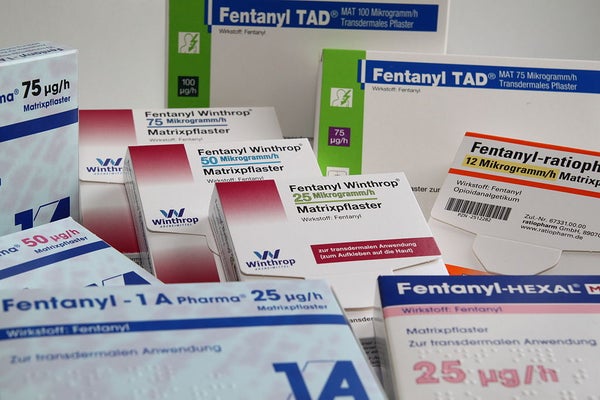Many questions still remain about the tragic and untimely death of musician and cultural icon Prince, but a report released last Thursday by the Anoka County, Minn., Midwest Medical Examiner’s Office answered a big one: Prince’s death was caused by an accidental overdose of the powerful opioid drug fentanyl. Little is known for certain about the circumstances leading up to his death but it now appears that, like millions of Americans, Prince was taking opioids to manage chronic pain.
Fentanyl is an opioid drug—a chemically synthesized relative of opiates such as morphine and heroin, which are derived from the opium poppy. The drugs mimic our brains’ own pain-regulating molecules called endogenous opioids, which act at receptors found throughout the nervous system. All opioid drugs have the ability to dampen pain. In fact, opioids are so good at relieving pain that they are considered the gold standard against which all other analgesic drugs are measured. But that relief comes with significant risks. Opioids carry a range of side effects, the most severe of which apparently took Prince’s life: death by respiratory depression, meaning that he stopped breathing.
“In a way, Prince is a poster child for what can happen with chronic use—and increasing doses—of these very powerful drugs,” says Gary Franklin, a researcher at the University of Washington and medical director of the Washington State Department of Labor and Industries. Franklin speculates that Prince, like so many others, may have been being treated with opioids for chronic pain and developed tolerance—meaning that over time higher and higher doses are required to achieve the same pain relief. As doses escalate, so do risks. “It turns out that it doesn't take long to develop physical dependence, which means that when you try to cut back on the dose, you get withdrawal symptoms. It’s a vicious cycle,” Franklin adds.
On supporting science journalism
If you're enjoying this article, consider supporting our award-winning journalism by subscribing. By purchasing a subscription you are helping to ensure the future of impactful stories about the discoveries and ideas shaping our world today.
If Prince had built up tolerance to opioids, how did he die of an overdose? The specific drug—fentanyl—found in Prince’s body is particularly powerful; it is 100 times more potent than morphine. For example, the effects of a standard 10-milligram dose of morphine can be achieved with just 100 micrograms of fentanyl. Among opioid drugs, fentanyl is particularly fast-acting, which can make it more lethal in some situations.
Prince had a long history of clean, drug-free living, suggesting that he would not use street drugs. However, fentanyl is often mixed with heroinor other drugs and sold illegally, which accounts for many of the other deaths in which it is involved—as users may be unaware that their heroin is cut with the stronger drug. And pharmaceutical fentanyl was once prescribed only for severe short-term pain, such as after surgery, but patients are increasingly receiving it to manage chronic pain, often in a patch that delivers the drug through the skin. Fentanyl is also administered in lollipop form, typically to terminal cancer patients with otherwise untreatable pain. Whatever the source, “we don’t know if Prince took the drug as directed or in excess,” says Lynn Webster, a pain and addiction specialist based in Salt Lake City and past president of the American Academy of Pain Medicine.
The death certificate did not name any other drugs in his system but a number of medications—from other types of opioids to sleeping pills—would have increased fentanyl’s risks in any user. Prince’s small stature—the medical report listed him as 1.6 meters and 50 kilograms at death—did not likely contribute to an overdose death, according to Webster. “Most people who die from respiratory depression—they go to sleep and don’t wake up,” Franklin says. “This was different in the sense that he [presumably] passed out while awake” in the elevator where he was found an estimated six hours after his death.
Despite the fact that Prince died of an overdose of an opioid drug, whether or not he might have been addicted is another matter. “I’m not so sure he was addicted,” Webster says. “I have not seen evidence that he was addicted.” An opioid user can develop tolerance and even physical dependence on the drugs without being addicted. Less than 10 percent of patients taking opioids for chronic pain develop addiction in the classical sense, Webster says.
Prince’s plane did make an emergency landing a few days before his death in order to get a life-saving dose of Narcan, or naloxone, a drug that counteracts opioids and can prevent overdose death. “The fact that he had already had an overdose episode—when death is prevented once by naloxone—that indicates big trouble,” Franklin says.
